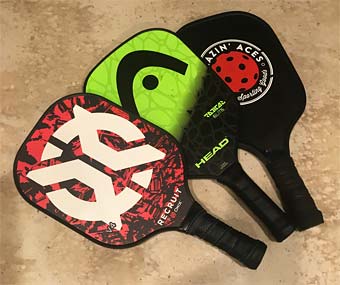Guide To Pickleball Paddles
Find the right paddle to elevate your game.

Pickleball Paddles
Pickleball is rapidly growing in popularity, attracting players of all skill levels. A key piece of equipment for every player is the paddle. Choosing the right pickleball paddle can enhance your game, but with so many options, it can be challenging to decide which one suits you best.
Pickleball paddles are available in different materials, each affecting your gameplay. The paddle material impacts power, control, maneuverability, and overall feel, making it essential to match your paddle to your playing style.
Wooden paddles, crafted from plywood or hardwood, are a classic and budget-friendly option. They're durable and provide a softer touch on the ball, ideal for beginners or players focusing on control. While wood paddles may lack power and responsiveness compared to modern materials, they remain a reliable choice for recreational games.
Composite paddles, made from graphite, fiberglass, or both, are highly popular among players. Graphite paddles are lightweight and stiff, offering excellent power and fast swing speeds, ideal for aggressive play. Fiberglass paddles focus on control and finesse, providing a softer feel on impact. Composite paddles combine the benefits of both, striking a balance between power and precision, making them versatile for different playing styles.
Carbon fiber paddles are gaining attention for their strength and performance. These paddles offer a mix of power and control, appealing to advanced and competitive players. The solid and responsive feel allows for fast ball speeds without compromising accuracy.
With so many materials available, the best choice depends on your preferences and skill level. Experimenting with different paddles can help you discover which one enhances your gameplay the most.
Other factors to consider include paddle weight, grip size, and surface texture. Lightweight paddles are easier to handle and swing quickly, while heavier paddles generate more power. Grip size affects comfort and control, so choose a size that feels secure in your hand. Textured paddle surfaces can also add spin and improve control, depending on your playing strategy.
As pickleball evolves, paddle designs and materials will continue to improve, offering players more options. Whether you're drawn to the classic feel of wood, the balanced performance of composite materials, or the high-tech advantages of carbon fiber, there's a pickleball paddle to fit every playing style and need.
Weight
The weight of a pickleball paddle plays a key role in gameplay. Heavier paddles deliver more power but can be harder to maneuver. Lighter paddles are easier to handle but may not hit as hard. Choose a weight that feels comfortable and suits your playing style.
Size
Paddle size affects sweet spot and control. Most paddles are 7.3 to 8 inches wide and 15.5 to 17 inches long. Larger paddles provide a bigger sweet spot, helpful for beginners, while smaller paddles offer better control and maneuverability.
Material
Paddles are made from wood, composite, or graphite. Wood paddles are affordable and durable but lack advanced performance. Composite paddles strike a balance between power and control. Graphite paddles are lightweight and high-performing but come at a higher price.
Grip
The paddle grip should feel comfortable and secure. Textured grips improve traction, and grip sizes vary between small and large. Choose a grip size based on your hand size to avoid discomfort or fatigue during play.
Price
Paddle prices range from under $20 to over $200. Higher-priced paddles often use better materials and deliver improved performance. Consider your budget and playing frequency when choosing a paddle to ensure it meets your needs.
Official pickleball paddles must comply to regulations. According to USA Pickleball rules, "The combined length and width, including any edge guard and butt cap, shall not exceed 24 inches (60.96 cm). The paddle length cannot exceed 17 inches (43.18 cm). There is no restriction on paddle thickness".
In summary, choosing the right pickleball paddle is essential for any player looking to improve their game. Consider factors such as weight, size, material, grip, and price when making your decision. Don't be afraid to try out different paddles to see which one feels best in your hand. With the right paddle, you can take your pickleball game to the next level and enjoy this fun and exciting sport even more.
Major Pickleball Paddle Manufacturers
Diadem Sports Pickleball Paddles
Franklin Sports Pickleball Paddles
Out West Sport Pickleball Paddles
Selkirk Sport Pickleball Paddles
